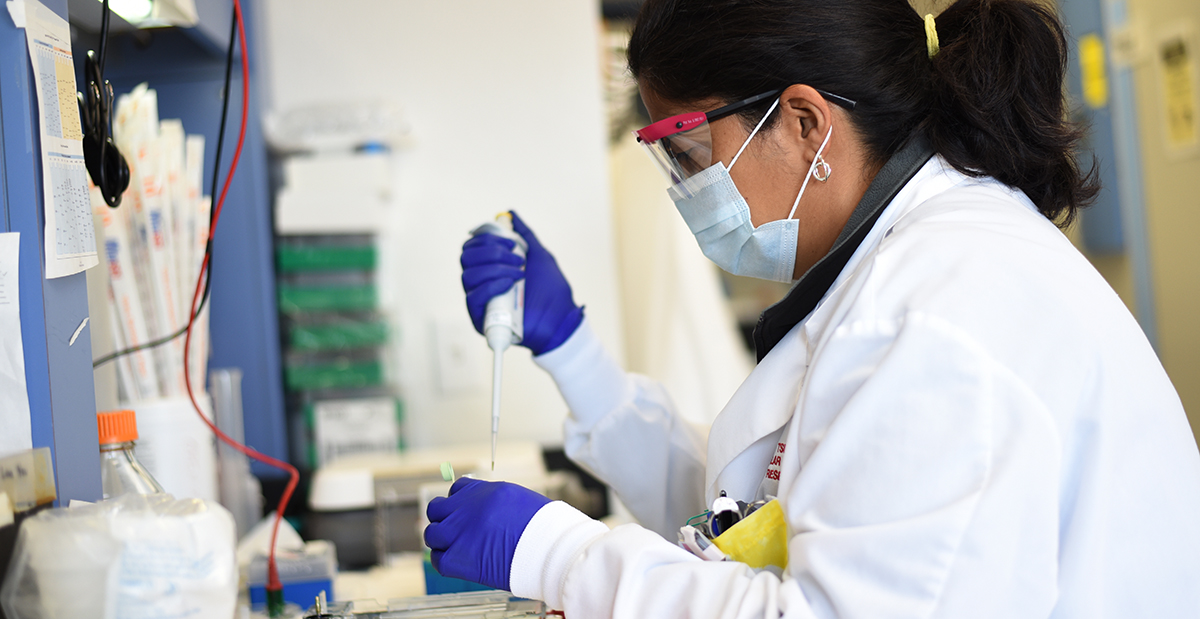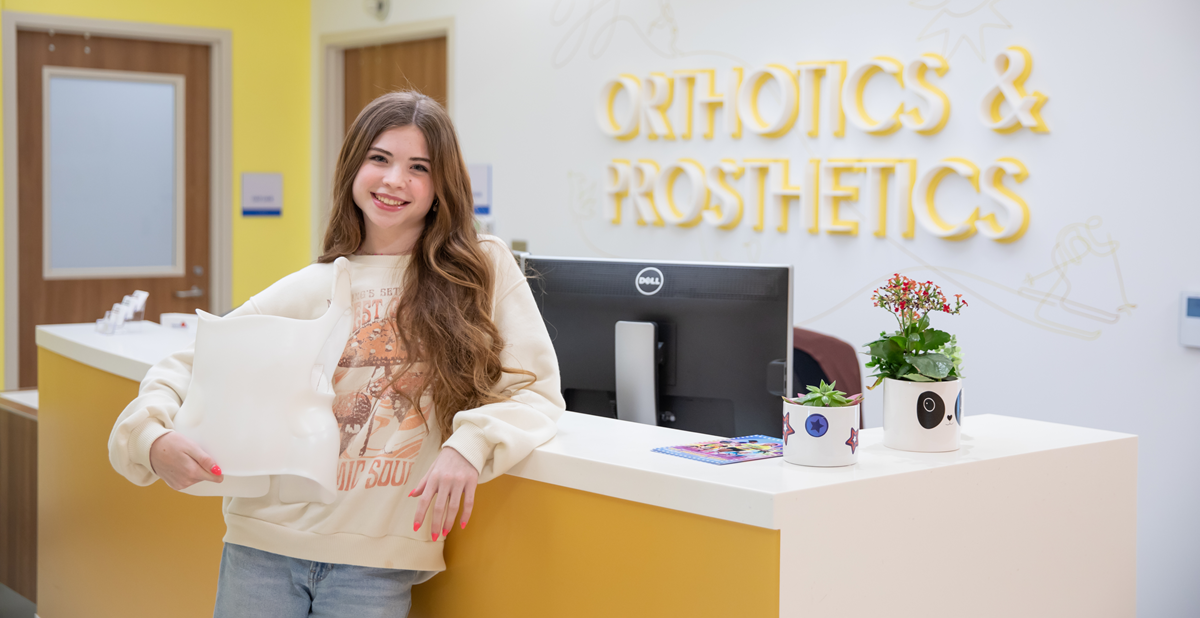
Jun 23, 2021 / Research & Innovation
Innovations in Scoliosis
Content previously published in Rite Up, 2021 – Issue 1.
The experts at Scottish Rite for Children are world-renowned for pediatric orthopedic treatment, research and education for many conditions, including scoliosis. The Sarah M. and Charles E. Seay/Martha and Pat Beard Center for Excellence in Spine Research provides the framework to analyze current treatment methods and protocols for scoliosis while leading the way for future innovative solutions.
Genetics are the Key
Director of Basic Research and Molecular Genetics Carol Wise, Ph.D., and her team continue decades of innovative research to find genetic risk factors that contribute to the complex disorder of scoliosis. “What’s exciting is that some of the pieces of the puzzle are starting to match together,” Wise says. “Now, it’s taking all
of those pieces back into the laboratory and understanding idiopathic scoliosis at a molecular level.”
Wise and Assistant Director of Molecular Genetics Jonathan Rios, Ph.D., have received several separate awards from the National Institutes of Health to fund idiopathic scoliosis research. Wise and Rios recently collaborated with the NIH Gabriella Miller Kids First Pediatric Research Program to generate and analyze 124 million megabytes of invaluable genomic data. With this information, the team moves closer each day to identifying the underlying causes of scoliosis leading to a future where scoliosis treatment for growing patients will look very different. “Our genetics research is getting to the fundamental causes of this condition that will inform less invasive therapies and prevention,” Wise says. “We are indebted to the thousands of patients and families who have partnered with us in working toward these goals.”
What's Old is New
Based on a physical therapy called the Schroth Method created in Germany in the early 1900s, an updated protocol, known as the Barcelona Scoliosis Physical Therapy School (BSPTS) method, is offered to Scottish Rite patients undergoing observation and treatment for the condition. “As a posturalbased exercise program, the Schroth-based method trains children around 10 to 14 years old to learn to correct the posture deviations that their scoliosis causes,” physical therapist Courtney Warren says. “By retraining their posture, the kiddos learn to stay in a corrected posture and not lean into their curve.”
Warren is one of six therapists at Scottish Rite extensively trained in the method that helps to lengthen muscles and ligaments and increase mobility for patients with scoliosis. Scottish Rite is currently investigating the use of Schroth-based physical therapy alone and combined with brace treatment for patients with mild scoliotic curves. “Having scoliosis is a marathon, not a sprint,” Warren says. “It’s a slow, learned technique that they have to digest as they go along, but hopefully, when the hard work is through, we’ll see a lot of really good outcomes.”
Tracking Brace Wear with the Brace RiteTM App
Thanks to a quarter-sized Bluetooth temperature sensor placed in each custom-made scoliosis brace, Scottish Rite for Children patients, along with their parents, can effectively monitor their brace wear. A study published in The Journal of Bone and Joint Surgery by Scottish Rite researchers found that patients who had brace compliance monitoring increased their daily time in the brace and also showed less scoliosis curve progression following bracing treatment.
“We want to get kids to wear their brace more,” Director of Orthotics Don Virostek, C.P.O., L.P.O., says. “If we can get them to wear their brace, we can hopefully keep more of those kids from having surgery for their scoliosis.” The specialized sensor tracks wear data and syncs up with Scottish Rite’s own Brace RiteTM app, which provides an accessible, immediate way for the patient to view their wear time stats and self-correct to meet their brace-wear targets. “The goal is to have them buy into the bracing program,” Virostek says. “By giving patients and their family the ability to see their wear in real-time, they can be an active participant in their own treatment.”
The experts at Scottish Rite for Children are world-renowned for pediatric orthopedic treatment, research and education for many conditions, including scoliosis. The Sarah M. and Charles E. Seay/Martha and Pat Beard Center for Excellence in Spine Research provides the framework to analyze current treatment methods and protocols for scoliosis while leading the way for future innovative solutions.
Genetics are the Key
Director of Basic Research and Molecular Genetics Carol Wise, Ph.D., and her team continue decades of innovative research to find genetic risk factors that contribute to the complex disorder of scoliosis. “What’s exciting is that some of the pieces of the puzzle are starting to match together,” Wise says. “Now, it’s taking all
of those pieces back into the laboratory and understanding idiopathic scoliosis at a molecular level.”
Wise and Assistant Director of Molecular Genetics Jonathan Rios, Ph.D., have received several separate awards from the National Institutes of Health to fund idiopathic scoliosis research. Wise and Rios recently collaborated with the NIH Gabriella Miller Kids First Pediatric Research Program to generate and analyze 124 million megabytes of invaluable genomic data. With this information, the team moves closer each day to identifying the underlying causes of scoliosis leading to a future where scoliosis treatment for growing patients will look very different. “Our genetics research is getting to the fundamental causes of this condition that will inform less invasive therapies and prevention,” Wise says. “We are indebted to the thousands of patients and families who have partnered with us in working toward these goals.”
What's Old is New
Based on a physical therapy called the Schroth Method created in Germany in the early 1900s, an updated protocol, known as the Barcelona Scoliosis Physical Therapy School (BSPTS) method, is offered to Scottish Rite patients undergoing observation and treatment for the condition. “As a posturalbased exercise program, the Schroth-based method trains children around 10 to 14 years old to learn to correct the posture deviations that their scoliosis causes,” physical therapist Courtney Warren says. “By retraining their posture, the kiddos learn to stay in a corrected posture and not lean into their curve.”
Warren is one of six therapists at Scottish Rite extensively trained in the method that helps to lengthen muscles and ligaments and increase mobility for patients with scoliosis. Scottish Rite is currently investigating the use of Schroth-based physical therapy alone and combined with brace treatment for patients with mild scoliotic curves. “Having scoliosis is a marathon, not a sprint,” Warren says. “It’s a slow, learned technique that they have to digest as they go along, but hopefully, when the hard work is through, we’ll see a lot of really good outcomes.”
Tracking Brace Wear with the Brace RiteTM App
Thanks to a quarter-sized Bluetooth temperature sensor placed in each custom-made scoliosis brace, Scottish Rite for Children patients, along with their parents, can effectively monitor their brace wear. A study published in The Journal of Bone and Joint Surgery by Scottish Rite researchers found that patients who had brace compliance monitoring increased their daily time in the brace and also showed less scoliosis curve progression following bracing treatment.
“We want to get kids to wear their brace more,” Director of Orthotics Don Virostek, C.P.O., L.P.O., says. “If we can get them to wear their brace, we can hopefully keep more of those kids from having surgery for their scoliosis.” The specialized sensor tracks wear data and syncs up with Scottish Rite’s own Brace RiteTM app, which provides an accessible, immediate way for the patient to view their wear time stats and self-correct to meet their brace-wear targets. “The goal is to have them buy into the bracing program,” Virostek says. “By giving patients and their family the ability to see their wear in real-time, they can be an active participant in their own treatment.”



